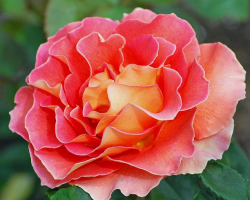Mirabilis belongs to many years of herbaceous flowering plants included in the Niktagin family, which is also called at night. More than 50 species belong to this genus.
Content
- What are the varieties of Mirabilis?
- Growing mirabilis from seeds
- Growing Mirabilis: What place to choose for landing?
- Soil for planting mirabilis
- When can I plant the seedlings of Mirabilis in open ground?
- How to plant Mirabilis in open ground?
- Mirabilis care
- How to collect the seeds of Mirabilis?
- How to deal with diseases and pests of Mirabilis?
- Video: growing mirabilis on the site
The homeland of this plant is moderate and tropical latitudes, but gradually it has become common all over the world. Its name translates as “amazing”, and this confirms the spicy aroma of the flower, its powerful stems with side processes and a wonderful ability to fragrant at night when flowers are revealed, turning into a thick green shoot during the day. If the street is frowning and cloudy, the flower continues to be open. The night beauty blooms, starting in July, flowering continues until the start of frosts.
What are the varieties of Mirabilis?
- Yalapa, also called Mirababisi laxative.Its height is from 30 to 80 cm, shoots with bright green large leaves are erects and are quite branched. Flowering begins in June, when shield inflorescences are revealed, consisting of flowers having a funnel -shaped shape and diameter, reaching 2.5 cm. The most common colors are red, pink, white, yellow and lilac.

- Iolanta.The bush reaches half a meter in height, and has a rounded shape. On massive knotted stems with a branching upper part are middle -sized funnel -shaped flowers. Their feature is stripes and strokes of different colors located on the petals.
- Elvira.This variety with bushes of medium height, has branched shoots, smooth and dense. The dark green plate of the leaf is oblong, pointed up. The flower in diameter reaches 3.5 cm. When flowering, it emits a sweet, rich aroma.

- Marblax, or Marble Mirabilis.The flower of these marble varieties resembles a palette of an artist - a variety of strokes, stripes, drops of different colors. The red-white version is a white petal with splashes of red-puncture tones. Yellow-red is a palette that also includes orange-pink colors. There is also a yellow-white gamut of the color of flowers.
- Red candy.A tall plant reaching almost a meter in height. On pale green smooth and thick stems are oblong oval leaves, having slightly wavy edges. Flowers are funnel -shaped, reaching a diameter of 6 cm. The color, as the name understands - rich red. There is a similar variety “Lollice” of white, yellow, purple color.

- "Tea Time".There is also a variety of varietal mixture, the color scheme of which is represented, among other things, orange-raspberry shades. So, red is the average in height of the bushes, quite compact, with knotted shoots branching at the top, densely dotted with oblong leaves. Medium -sized flowers have a bright pink color. But the mixing variety is quite high, the bush grows to 90 cm and has a spherical shape. Obligated leaves have sharp tips. Naked from below, shoots begin to branch in the upper part. The flowers are smooth, having wavy edges, in diameter reach 2.5 cm.
- Multi -flowered.It is less common, its naked straight shoots also have branchy tops. The sheet is smooth, oval in shape, and in axillary inflorescences-up to 6 purple flowers with a diameter of up to 6 cm. It begins to bloom earlier than usual, in May.
- Cool -leaved.This variety of Mirabilis reaches 30 cm. It has 5-7 cm oval leaves with a slightly sticky surface. In the apical inflorescence - three large purple flowers, reaching 10 cm in diameter.
Growing mirabilis from seeds
- Flying, Mirabilis gives fetus, similar to a long nut of dark brown color. It retains the ability to germinate for three years, if you store it in a place where it is dark and dry. For seedlings, the seeds are sown, starting from the last days of March to the middle of April.

- If the seeds are not processed, the duration of the germination is about two weeks. To accelerate this process, they are Scripture, i.e. Nadfil or sandpaper rubbing the fetus. You can also soak the seeds by immersing them in warm water so that they are not completely in it, and leave for 20 hours.
- Prepare small but deep plastic glasses, taking into account the development of the root system in depth, and fill them with a substrate. You can use the finished universal soil mixture intended for seedlings. If this is not possible, prepare the mixture yourself using neutral or alkaline soil.
- The composition of the mixture: Peat and sod land - 2 parts, humus - 1 part. Add half of the sand, after washing it, and half a glass of wood ash (can be replaced with two tablespoons of dolomite flour). Mix all components thoroughly and, in order to disinfect, soak a weak solution of potassium permanganate. You can also warm the soil mixture in the oven (the temperature should be about 200 ° C).
- Now fill the plastic cups with the resulting composition by about three quarters, squeezing them slightly. The bottom can be extended with a drainage layer, for which chopped brick or foam, expanded clay, pebbles are suitable. Plant a pair of seeds in each and pour in the ground about a centimeter. All completed cups should be moistened using not watering, but a fine dispersal spray. Take glass or film and cover the cups. Select for them a place with multiple lighting, the temperature should be 18-20 ° C. After the appearance of sprouts (on average after 5-6 days), remove the coating.
- When the first real sheet appears, smash the sprouts, cutting the escape to the ground with scissors, which is weaker. The remaining sprout feed the drug Strpush (or, as an option, solution, Fermatics). Make sure not to fill in seedlings - she does not like waterlogging. Watering only when the soil is completely dried up. When the shoots grow to 10-15 cmProvide them more spacious tanks by passing the soil in them. Then conduct a second top dressing, this time - by adding complex mineral fertilizers
- Another important point - turning shoots. Start doing this one a couple of weeks before you are going to plant the plant in open ground. For hardening every day, “walk” seedlings in the open air (you can on the balcony or in the garden). The last days before planting, seedlings must be kept around the clock.
Growing Mirabilis: What place to choose for landing?
- Since Mirababi belongs to heat -loving plants, the best place for its planting will be where enough light, sun and warmth. In principle, Mirabilis will take root in partial shade, but at the same time will lose in the brightness and size of the flowers. The plot should be protected from draft and do not blow with winds.
- As already mentioned, Mirabilis does not like excessive humidity, especially if she stagnates in the roots. Out of these reasons, make sure that in the place where you are going to plant the plant, there is no close occurrence of groundwater, it is better to plant a mirabilis on a hill. And another factor is a fairly high aggressiveness of the plant, which can lead to the fact that it will begin to replace the neighbors. Therefore, plant it away from other colors and bushes.
- However, if you plant low -growing varieties of Mirabilis, then they can be framed by borders, flower beds, rockers, where they can adjust with roses of tall varieties, peonies or dolphiniums, zinnia and chamomile.
- A low mirabilis will look good in the pot, and high specimens will become excellent live fences. If you want to decorate the borders of garden paths, then consider that they grow very widely, so do a “supply” of centimeters of 40-50 to the edge when planting.
Soil for planting mirabilis
- Just as for planting seedlings, you need soil with an alkaline or neutral reaction, with moderate fertility.
- If the soil is acidic, you will have to resort to lime. But the loam, like clay, well drainage soil, is perfectly suitable.
When can I plant the seedlings of Mirabilis in open ground?
- The planting of seedlings from the seeds of Mirabilis is carried out after the frosts finally end and the soil warms up at least 10 ° C.
- As a rule, this is the last numbers of May. If the plant is planted in open ground directly with seeds-this can be done starting from the middle-end of April.
How to plant Mirabilis in open ground?
- If you are sowing the seeds yourself, and not the seedlings spent from them, the step between them should be approximately 7-8 cm, and the depth of the seal in the soil is about 3 cm. Then pour the ground with cool, but not cold water and cover with polyethylene or material from Non -woven canvas. So you protect germinating seedlings from possible frosts. When the soil warms up, and frosts will no longer threaten growing shoots, the coating can be removed. It is possible that the seedlings will be too thick, and then you will have to tackle them.
- If we are talking about already germinated from seeds of the seedlings of Mirabilis, then before starting the landing, in about a couple of hours, pour it so that it can easily get out of the glass. In open ground, dig the holes to the depth and width of the earthen coma, which formed around the roots, and simply carefully “dump” the contents of the glass. Rub the ground slightly with your hands, if necessary, add. The correct position of the root neck after planting is at the level of the surface of the soil.
- Maintain a distance of up to half a meter between the sprouts, since the plant will become more and more bushy as it grows, and it will need more space. When all the seedlings are planted, fill the holes and pour the site. The soil can be mulching, for this, peat or wood ash is suitable.
- By the way, if Mirabilis has grown in your garden or on a flowerbed, then the seeds are able to germinate themselves, the plant’s plant propagates quickly and successfully. It will only be necessary to sake new shoots or, if desired, transplant them to where you planned.
Mirabilis care
- The care of the growing shoots of Mirabilis is simple - timely weeding and from time to time - loosening of the soil is necessary. Lube mirabilis so that he does not thicken. Thick shoots, firstly, looks unattractive, and, secondly, this can provoke a plant disease. The bushes can also be trimmed, giving the shape you need.

- For lush flowering in drought, the plant should be watered quite abundantly, up to three times a week, so that budding is high -quality and continuous. If rains are charged - mirabilis does not require watering. Do not forget to loosen the soil after watering, so that a crust does not form on its surface, which will make it difficult to enter oxygen to the roots. As necessary, weeds can be broken simultaneously.
- While the plant is growing, he will need 2-3 top dressing. The first top dressing is carried out after landing, the second - in July, and at the end of summer. Fresh organics are not suitable for fertilizer, it is better to use compost or humus. You can fertilize the soil with complex mineral fertilizers, the main thing is to make the proportion so that the second and third top dressing has a minimum fraction of nitrogen.
- When the flowering ends, the flowers that dry out if you do not need propagation by self -sowing, it will be necessary to remove. If you want to collect seeds, then wait for their color to become almost black. If the seeds do not ripen, then there will be no seedlings from. At the first frosts, green shoots are also cut, leaving about 10 centimeters from them, after which they allow to dry. If you want to try to propagate Mirabilis with tubers next year, dug the rhizomes and drying them in sunlight, pack it, pouring with wood sawdust (sand is also suitable).
- It is best to store tubers in the cellar at temperature from 3 to 7 ° C. But if you notice that a growth point has appeared on the colors, it is better to transfer the tubers to a colder place, you can store them in the refrigerator. The tubers in the next spring can be sprouted, like seeds, or planted immediately in heated soil. If you want to leave plants in the ground for the winter (and in the southern zones this is possible), then before the start of frosts they need to be well covered with straw or wood sawdust, since Mirabilis is afraid of the cold weather.
How to collect the seeds of Mirabilis?
- To save the bush color gamut you like, Mirabilis tubers are dug in the fall and cleaned in a dark and cool place before spring, sprinkling with a small amount of sawdust or peat on top.
- With the advent of spring, after the threat of frost passes, the tubers are planted in prepared soil.
How to deal with diseases and pests of Mirabilis?
- Mirabilis is enough resistant to various diseases. It really threatens him only by an excess of moisture or its stagnation in the root system (gray rot or black leg)-then the roots can begin to rot.
- Treatment here is impossible - a sick bush must be dug up. After it will need to be burned, and the place where the bush grew is treated with the help of foundazole or other solution of fungicides. To avoid such a situation, the plant is not planted in places with close adjacent underground waters and watered only as necessary.
- Very rarely, Mirabilis can suffer from fungal diseases such as rust or spotting. Treatment consists in treating the bush with a fungicide (tricepermin or phytosporin are suitable) after removing flowers and leaves from it, which were infected. Disinfection can be fixed with a solution of potassium permanganate. As a prevention, it is necessary to treat the soil with boiling water with boric acid dissolved in it before planting.
- If the plant is affected by the invasion of nematodes, the best way out will be the landing nearby of balett bushes.
We will also tell you how to grow from the seeds:







